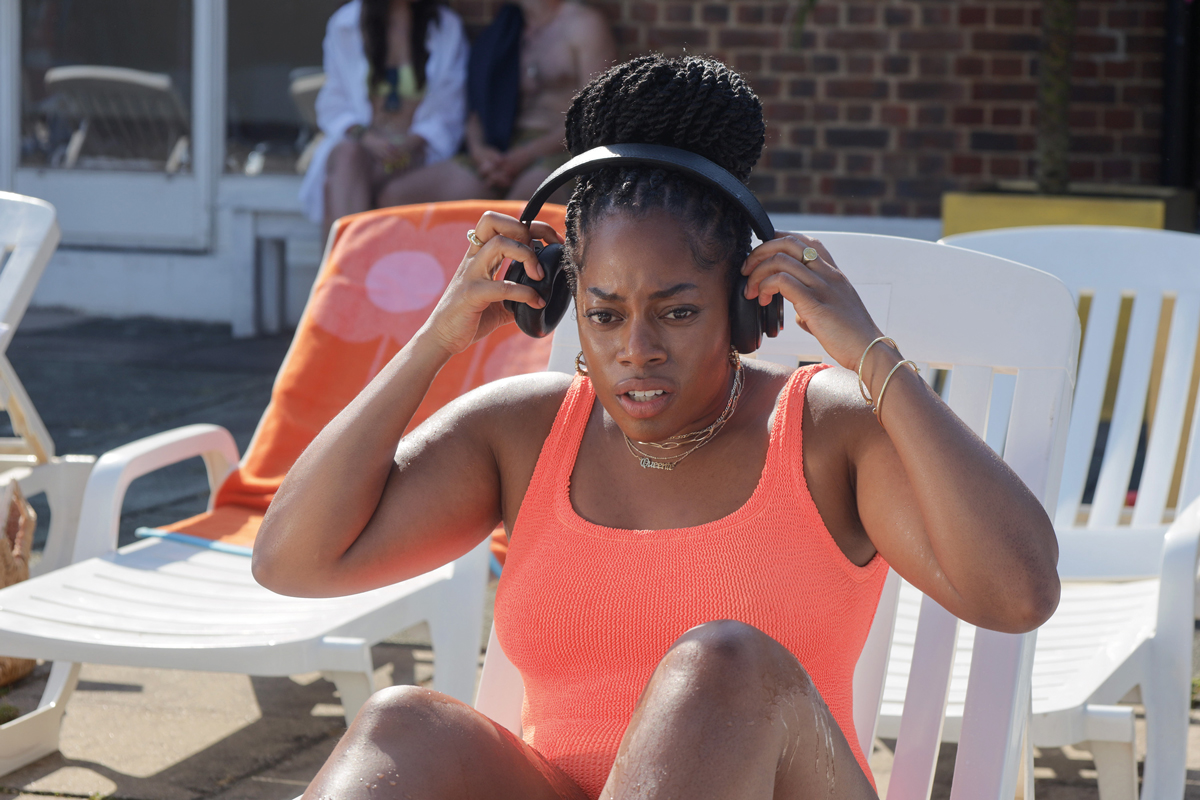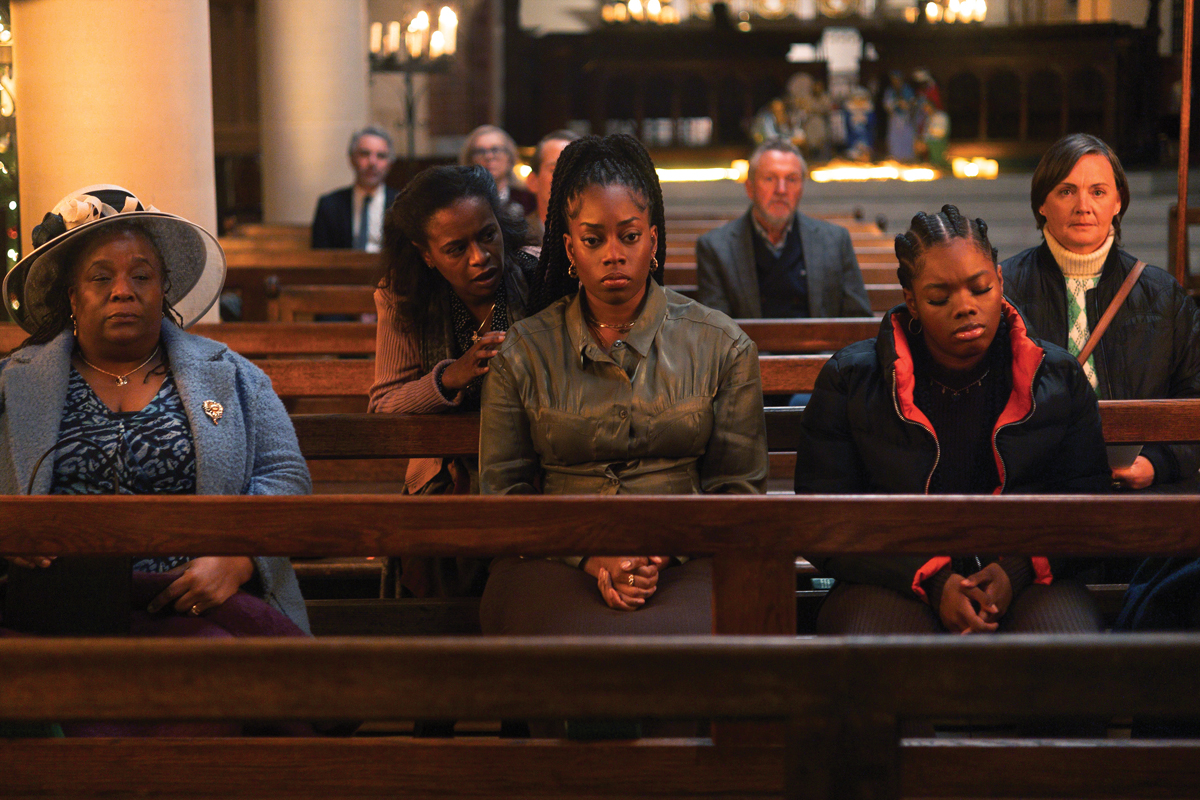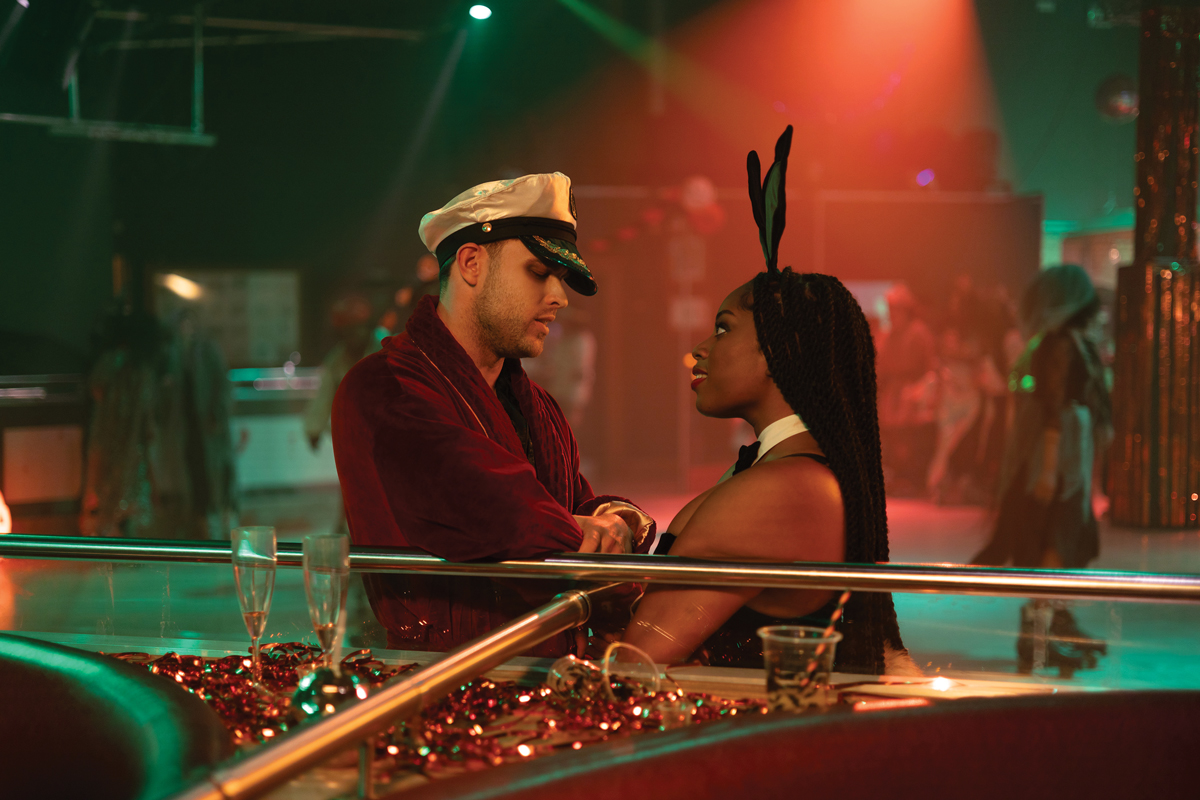
Queenie
Posted on Jul 16, 2024 by Samara Husbands
Queen Bee
DOP Nathalie Pitters talks collaboration and creative problem-solving on-set for Queenie, the TV adaptation of Candice Carty-Williams’ hit novel
Words Nicola Foley Images Lionsgate/Latoya Okuneye
Queenie, the bestselling novel by Candice Carty-Williams, became a literary sensation when it was released back in 2019. A dark-but-funny exploration of Black womanhood, trauma, healing and (a lot of) sex, the book’s bright-pink cover was inescapable. Its messy protagonist – a mid-twenties, British-Jamaican woman in Brixton navigating love, life and a burgeoning journalism career – was even hailed as a modern-day Bridget Jones. So when news of the TV adaptation started circulating, expectations were sky high: a fact that didn’t escape Nathalie Pitters.
“It was so anticipated, because the book was so successful, that I did feel a lot of pressure while I was shooting: I knew a lot of people were going to watch this!” admits Pitters, who worked as DOP on episodes 5-8. “But every day I came home so happy with what I’d shot that day, and so proud of myself, my team and all the collaboration. I’m really pleased that it’s resonating with the audience as well.”
The series, released in eight parts, was developed by Further South Productions in association with Lionsgate Television for Channel 4, and directed by Joelle Mae David and Makalla McPherson, with Carty-Williams stepping into the roles of showrunner and exec producer, and Lisa Walters as co-executive and series producer. Ryan Calais Cameron, Yolanda Mercy, Natasha Brown and Thara Popoola joined Carty-Williams in the writing room. Scanning the crew list, it’s clear that this was a decidedly female-led team, which is a dynamic Pitters relished.
“I’ve been fortunate in my career so far to have been a part of numerous productions that favoured a female majority in the crew members, which is a sign that things are changing. That can only be a good thing, diversifying our teams and our stories allows for a range of perspectives to be shown,” she reflects. “Especially for Queenie, where our main actor was going through a carousel of emotions and intimate scenes, having a strong female presence on-set helped her feel safe.”
In harmony
Pitters found her way into the project through her relationship with director Joelle Mae David, who she’d previously worked with on the BBC series Dreaming Whilst Black. Following a successful interview, she was selected as DOP on the second half of the series, with Rachel Clark lensing the opening block. The two cinematographers knew each other already, which helped foster a close collaboration throughout production.
“Being able to harness that relationship was really useful,” muses Pitters. “And Rachel was so generous, inviting me to her lens test – not everyone does that. She was block one and set the look, but I was so thankful to her for including me. I had access to her rushes and every week there’d be an assembly put in so we could discuss things like how she was approaching night scenes and close-ups. It meant I could understand the direction they wanted me to go in, which was helpful when I came to shoot.”
In defining the look for the show, Clark and the show’s colourist, Jateen Patel from Harbor Picture Company, set a series of LUTs: one warm, one cool and a ‘trauma LUT’, which was a couple of stops down and had a darker, grungier aesthetic. Also running throughout the series is a sound motif, a tinnitus-like ringing, which amps up as Queenie’s anxiety rises. “There was a clear visual language for that: centre frame Queenie on the Canon Dream and slowly push in a few feet,” shares Pitters.
“The storyline was very different in my block,” she continues. “Block one deals a lot with the consequences of Queenie’s trauma: she breaks up with her boyfriend and has a downward spiral of drinking a lot, sleeping around and making quite bad choices. Then, in my block, we see Queenie facing the trauma head-on in therapy, and starting the journey towards healing and beginning to feel okay. It felt like block one’s journey was going down, and block two’s journey was going back up – so we had to have quite a different visual language to describe that.”
As well as the Canon Dreams, the DOPs used Canon SKs for the bulk of filming and Todd AOs for the flashback scenes, with these vintage anamorphic lenses providing a look well suited to the period aesthetic as the show jumps back in time. The camera of choice, the Sony VENICE, impressed Pitters with its dual native ISO capability, crucial for maintaining detail in both highlights and shadows across various lighting conditions.
“I wanted to retain details in the highlights for the day scenes and in the shadows for the night scenes, so I settled on ISO 1250 for both – for the day scenes, that meant going at a base of 500 and setting the camera to 1250, and for night scenes I set the base to 2500 and set the camera to 1250,” she explains. Close collaboration with the DIT ensured they achieved this without introducing unwanted noise.
On the lighting front, Pitters is most pleased with a scene in episode 6: a flashback taking place in house of Roy, Queenie’s mother’s abusive boyfriend. “We had some really interesting locations,” she recalls. “There was this old house where we used one room for Roy’s house and another for the hostel they stay in afterward. We had to tent out the whole house – which was a challenge as it was a big space. We worked mostly with LEDs – it was the height of summer and we needed to keep things cool!”
Pitters wanted Roy’s house to have a ‘sickly’ and unsettling mood. To achieve that: “we balanced the light to tungsten, then added some plus green and gelled the light with CTS. The colour temperature ended up around 2700K with a half plus green,” she explains.
Similarly in the hostel scenes, she created a mix of cosy, warm tungsten and unpleasant, green-blue fluorescent hues, aiming for an environment that felt both homely and slightly hostile. Additionally, they incorporated practicals in the form of street lighting from the outside.
One of the most challenging scenes to shoot was Queenie’s birthday in episode 7, which required creative problem-solving from the team. “The way the script was written versus the geography of the house meant we’d be jumping around rooms in a way that didn’t make geographical sense,” reveals Pitters. “We needed the scene transitions to make sense, so we worked closely with Makalla, the AD, the production designer and continuity, and made a cardboard model of the house with stick-figure characters to map out the scenes. We kind of rewrote the scene in a way that made sense for the layout of the house, and basically filmed a little stick-man disco!” she laughs.
“It meant that, on the day, we were completely seamless, and we knew who was where and what was happening next at all times – we had a lot of cast on-set so it could have all exploded, but it didn’t because we put so much work into the prep. I’m really proud of the collaboration during that process.”
The first few therapy session scenes were challenging due to their closed-set approach, which initially excluded even Pitters. This created an intimate atmosphere but proved impractical, leading to adjustments. “We wanted a sense of stillness, with set designs incorporating green for growth and calmness,” shares Pitters. The first therapy session was designed to be neutral and cool, focusing on the actors’ performances without flashy techniques. For the session in episode 7, the warmer tone reflected Queenie’s progress.
The team conveyed claustrophobia and the stigma of therapy in the Black community for the initial session by keeping distance from Queenie, avoiding direct eyelines until her panic attack. This approach required balancing the need for tight shots with the actors’ ability to connect, sometimes compromising on ideal set-ups to prioritise performance. “At the time, I wasn’t sure if we’d made the right decision by not pushing for the shots we wanted, but the performances were stronger for it, and ultimately that’s all that matters,” Pitters reports.
Dream job
Looking back on the experience of shooting Queenie, Pitters describes it as a beautiful process, offering the kind of dynamic she has long hoped for in her working life. “I had such a nice time, and it was a situation where I really got that one-on-one time with the director. Due to the fact that we were shooting block two, decisions for casting and locations were already taken care of by block one because they were shooting before us.
“So that meant Makalla and I were able to sit in our production base, and made it our weird little home,” she continues. “We wrote things on the whiteboard, and we would just sit and analyse and bounce ideas back and forth; it was such a collaborative process.”
Looking forward, Pitters highlights the importance of communication with the crew, a lesson reinforced by the logistical challenges of prepping while her camera team, gaffer and grip shot block one. “There were times I wanted to recce or discuss a scene, but they couldn’t because they were on-set. Ultimately, it taught me the importance of communication with the crew and finding their best way of communicating, not just mine,” Pitters reflects. “Maybe this person works better with diagrams, that person works better with video. It’s about understanding more about each crew member’s preferred method.”
This feature was first published in the August 2024 issue of Definition.












